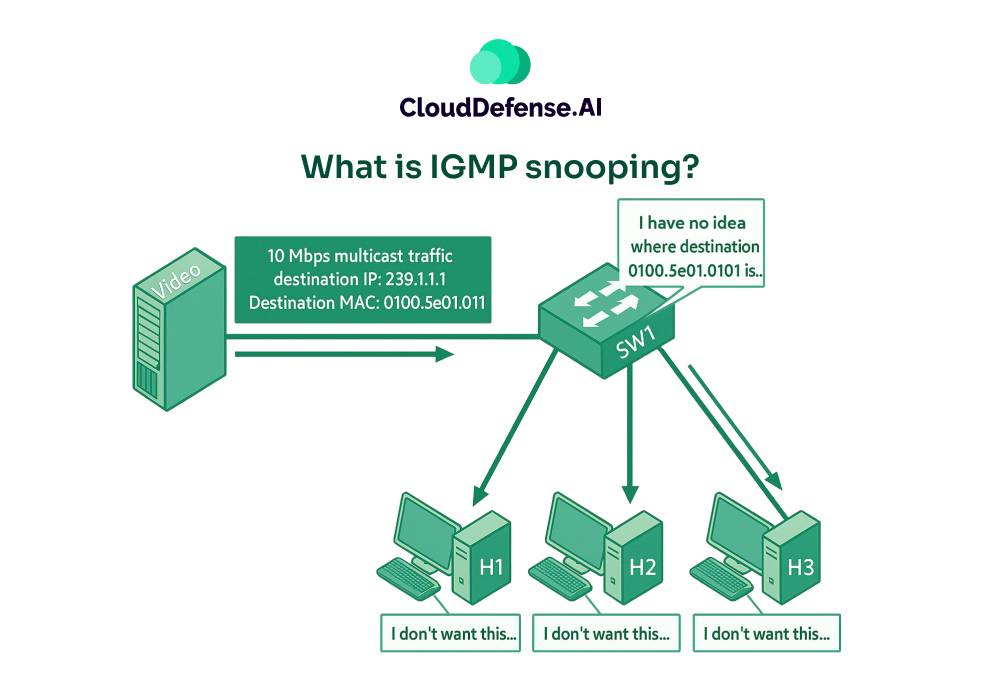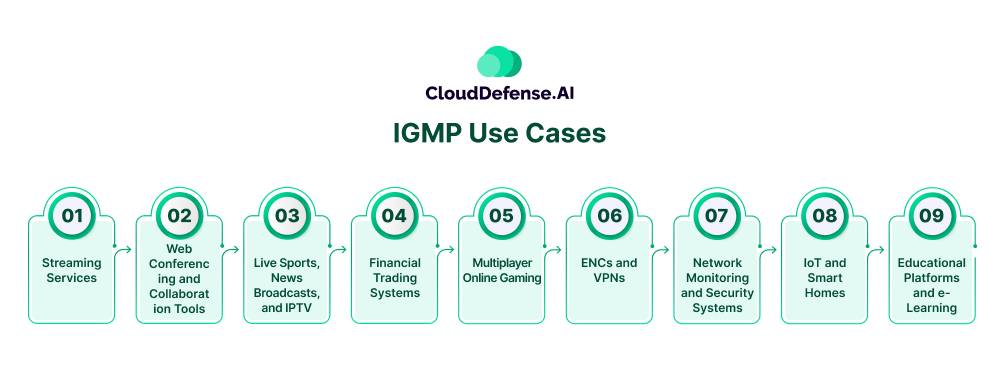What is IGMP?
The Internet Group Management Protocol, or IGMP, is part of the TCP/IP suite, allowing multiple devices to share a single IP address for receiving identical data streams. First specified in 1989 in RFC 1112, Internet Group Management Protocol manages multicast groups, enabling efficient data transmission over IPv4 networks. While it exclusively supports IPv4, the equivalent protocol for IPv6 is Multicast Listener Discovery.
IGMP helps organize multicast groups for IP data streams, ensuring that devices interested in specific content can receive it without overloading the network. When a sender needs to transmit data to multiple receivers, Internet Group Management Protocol handles the group management through routers rather than the sending device itself.
What is Multicasting?
Multicasting is a method of transmitting data to multiple devices simultaneously. Unlike unicast, where a unique data packet is sent to each device, or broadcast, where data is sent to all devices, multicasting sends data to a selected group. This technique reduces bandwidth consumption and allows efficient data distribution.
In practical terms, multicasting is like sending a company-wide email to a mailing list. All employees on the list receive the same email, similar to how all devices in a multicast group receive the same data packets.
For example, streaming services such as Netflix and live broadcasting platforms heavily depend on multicasting. Without it, they would need to send individual streams to every user, causing high bandwidth usage and slower performance.
How does IGMP work?

IGMP operates between the sender, receivers, and network routers. Here’s how the protocol functions:
- Joining a Group: A device interested in receiving multicast data sends an Internet Group Management Protocol membership report to its router. This request informs the router that the device wants to join a specific multicast group.
- Multicast Data Transmission: Once the request is processed, the router forwards multicast data to the group. This data is replicated only as needed, ensuring efficient use of bandwidth.
- Leaving a Group: If a device no longer wants to receive data, it sends a “leave group” message. The router then removes the device from the group and stops forwarding multicast data to it.
Internet Group Management Protocol uses IP addresses from the 224.0.0.0 to 239.255.255.255 range for multicast. These addresses are shared across all devices in the multicast group, and routers track which devices are part of which groups to manage the traffic accordingly.
What is IGMP snooping?

IGMP snooping is a network optimization technique that allows switches to monitor Internet Group Management Protocol traffic between routers and devices. Normally, switches operate on Layer 2 (data link) of the OSI model and don’t handle Layer 3 (network layer) activities like IGMP. However, with IGMP snooping, switches can listen to IGMP messages to determine which devices should receive multicast traffic.
This method prevents unnecessary data from being forwarded to all devices on the network, conserving bandwidth and improving performance. The switch creates an IGMP snooping table, which tracks which devices have joined a specific multicast group and ensures multicast traffic is only sent to those devices.
IGMPv1 vs IGMPv2 vs IGMPv3
Over the years, Internet Group Management Protocol has evolved through three versions, each building upon its predecessor to improve functionality and efficiency.
- IGMPv1 (1989): The original protocol version allowed devices to join multicast groups but lacked the ability for devices to leave a group voluntarily. Devices were removed only after a timeout period.
- IGMPv2 (1997): Introduced the “leave group” message, allowing devices to exit multicast groups immediately. IGMPv2 also brought improvements like group-specific queries, reducing the need for general membership checks.
- IGMPv3 (2002): The most advanced version, IGMPv3 supports source-specific multicasting, which allows devices to receive data only from specified sources. This version also introduced increased security and efficiency by filtering out unwanted or untrusted sources.
| Feature | IGMPv1 | IGMPv2 | IGMPv3 |
| Join Group Capability | Yes | Yes | Yes |
| Leave Group Message | No | Yes | Yes |
| Group-Specific Queries | No | Yes | Yes |
| Source-Specific Multicasting | No | No | Yes |
| Backward Compatibility | N/A | Yes | Yes |
IGMP Use Cases

The Internet Group Management Protocol is crucial for a variety of real-world applications where efficient data transmission to multiple devices is necessary. Below are some key scenarios where Internet Group Management Protocol is applied, highlighting its importance in different industries:
Streaming Services
One of the most widespread use cases for IGMP is in video and audio streaming services, such as Netflix, YouTube, and Spotify. These platforms need to deliver the same data streams to thousands, sometimes millions, of users. Without multicasting, each user would require their own individual data stream, leading to massive bandwidth usage, network congestion, and a potential crash.
With IGMP:
- The server sends a single copy of the video or audio data, and routers replicate it only where necessary, ensuring multiple users in a multicast group receive the content efficiently.
- IGMP enables seamless live streaming events, such as sports games or live concerts, where thousands of users want to tune in simultaneously without buffering issues.
Web Conferencing and Collaboration Tools
Internet Group Management Protocol is also instrumental in real-time collaboration tools like Zoom, Microsoft Teams, and Google Meet. These applications require live video and audio to be streamed to multiple participants, often across various locations.
With IGMP:
- Each participant in a web conference can receive the same video or audio feed in real-time, allowing for interactive collaboration.
- Internet Group Management Protocol reduces the strain on both the client and server by sending one stream to the multicast group, rather than sending multiple unicast streams to each participant.
Live Sports, News Broadcasts, and IPTV
Live sports broadcasts and news streaming services often rely on multicasting for delivering high-definition video streams to a large audience simultaneously. Internet Group Management Protocol makes these real-time, data-heavy transmissions possible by sending a single stream to multiple receivers, ensuring that millions of viewers can access the broadcast without delay.
For IPTV, IGMP provides the necessary support for delivering television services over the internet. By using multicast transmission, Internet Group Management Protocol helps service providers deliver high-quality video streams to multiple users, optimizing bandwidth usage.
With IGMP:
- Large-scale broadcasts like the Super Bowl or live news events can reach a global audience with minimal latency, ensuring that all viewers receive the same content at the same time.
- It improves the user experience by preventing network overload during peak viewing times, such as during popular sporting events.
Financial Trading Systems
Financial trading platforms rely heavily on low-latency communication to deliver real-time market data to traders. Market updates, stock prices, and financial news need to be broadcasted instantly to many traders to maintain a competitive edge in fast-paced environments.
With IGMP:
- Financial institutions can send market data updates simultaneously to multiple trading floors or online trading platforms.
- Traders receive real-time information on stock prices, enabling them to make informed decisions quickly without waiting for individual data streams to arrive.
Multiplayer Online Gaming
Internet Group Management Protocol also plays a significant role in multiplayer online gaming, where players in different locations connect to a single server and interact in real-time. Game servers must send updates, such as character movements, actions, or in-game events, to many players simultaneously.
With IGMP:
- The game server can send identical data packets to all players in the same group, ensuring that everyone experiences the game with minimal lag.
- This reduces the bandwidth load on the server while maintaining a smooth, synchronized gaming experience for all participants.
Enterprise Network Communications and Virtual Private Networks (VPNs)
Large organizations with distributed offices or users working remotely often employ multicast VPNs for secure, large-scale communication. This is especially common in industries like telecommunications and broadcasting, where businesses need to send data to multiple endpoints simultaneously.
With IGMP:
- Enterprises can efficiently distribute internal video broadcasts, webinars, or announcements to multiple remote offices or employees, reducing the need for excessive bandwidth consumption.
- Internet Group Management Protocol helps manage multicast groups within enterprise VPN environments, allowing for streamlined communication and collaboration.
Network Monitoring and Security Systems
Network monitoring tools often use multicasting to send performance and security updates to administrators monitoring various parts of a network. Additionally, security systems, such as CCTV cameras and surveillance networks, also benefit from multicasting.
With IGMP:
- Real-time video feeds from multiple surveillance cameras can be sent to a central control room simultaneously without overwhelming the network.
- Network monitoring systems can multicast alerts and updates to administrators across various locations, improving incident response times.
IoT and Smart Homes
As the IoT continues to expand, many smart home devices need to communicate with each other and with central controllers simultaneously. Devices like smart lighting, thermostats, and security systems rely on multicast to operate efficiently.
With IGMP:
- IoT hubs can send multicast commands to multiple smart devices at once, such as turning off all lights in a home or adjusting the thermostat for multiple rooms.
- IGMP ensures that the communication between these devices is efficient and doesn’t overload the home network with unnecessary traffic.
Educational Platforms and e-Learning
Internet Group Management Protocol is often used in virtual classrooms and e-learning environments where teachers and students interact in real-time. Whether it’s a university lecture streamed to hundreds of students or an online certification course, multicast transmissions are vital for delivering content efficiently.
With IGMP:
- Universities and educational platforms can stream live lectures to large groups of students, ensuring all participants receive the same quality feed.
- It allows interactive elements like live Q&A sessions, making it easier to scale educational services without overwhelming the network infrastructure.
Final Words
Internet Group Management Protocol is crucial for organizing multicast groups, ensuring efficient data distribution across IPv4 networks. From streaming services to financial markets, IGMP enables seamless data transmission to multiple devices without overwhelming network resources.
By evolving through three versions, IGMP has become more efficient and secure, cementing its role in modern networking infrastructure. Optimize your network’s performance by using IGMP and IGMP snooping to reduce unnecessary traffic and enhance data delivery.







